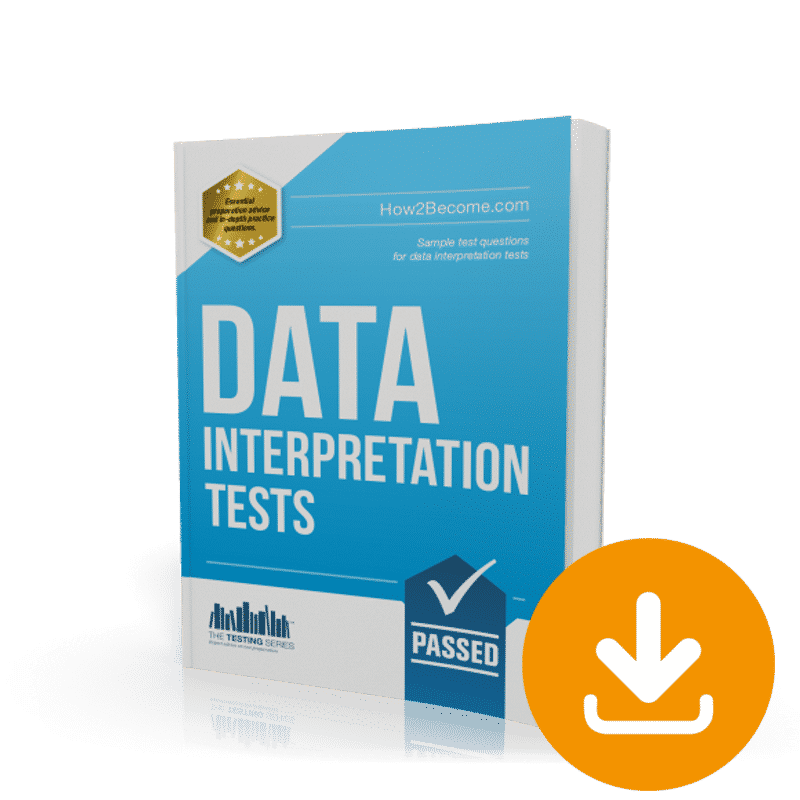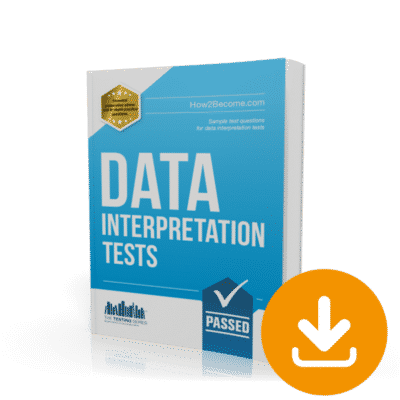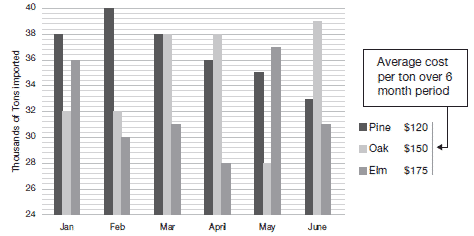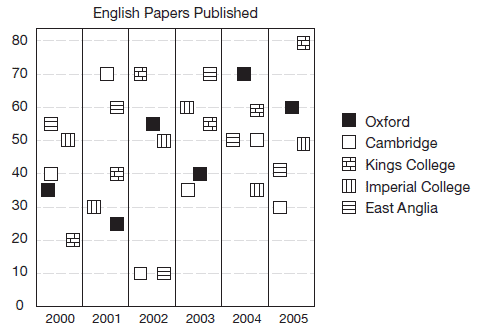
DATA INTERPRETATIONS TESTS
Sample test questions and answers for data interpretation tests!
4.9/5 Rating | 1,000+ Reviews ![]()
Training That Works
Discover insider secrets and a masterclass of testing practice material that has helped 100s of candidates pass their assessment tests.
Unlock Your Potential
Whether you’re just starting out or you know what to expect, you will get access to 100s of questions, with solutions that will catapult your chances of success.
Powerful Resources
Get instant access to the material right now which includes data interpretation questions based on charts, tables, and graphs.
WHAT ARE DATA INTERPRETATION TESTS?

WHERE ARE DATA INTERPRETATION TESTS USED?
Data Interpretation tests are part of the numerical selection process for a wide variety of job roles, so it is important that you get to grips with how to answer and pass these tests.
If you have applied for a job position which involves data analysis, data handling and interpretation, you can expect to be tested using Data Interpretation.
Data Interpretations is a general workbook; it is not designed for any career in mind. However, many jobs use this test as a way of assessing their candidates.
Typical roles that are likely to show the ability of assessing numbers and analysing data:
- Managerial
- Graduate
- Technical
- Clerical
TIPS FOR DATA INTERPRETATION TESTS

TOP TIP 1
During your preparation for the data interpretation test it is important that you understand why you answered a question incorrectly and how you arrived at your chosen answer. If you take the time to check your answers carefully then this will undoubtedly improve your performance when you sit the real test.
TOP TIP 2
Attempt a variety of different testing questions from a range of areas, such as generic psychometric tests, numerical reasoning, verbal reasoning, fault analysis and spatial reasoning etc. This will undoubtedly improve your overall ability to pass the test that you are required to undertake.


TOP TIP 3
During the test aim for SPEED as well as ACCURACY. Many test centres want to see how quickly you can work, but they also want to see how accurate your work is, too. Therefore, when tackling the tests you must work as quickly as you can without sacrificing accuracy.

PASS YOUR DATA INTERPRETATION TEST

- TIPS – top tips for passing the tests including what you should do and what you should try to avoid.
- OVER 300 QUESTIONS – the workbook purposely provides you with lots and lots of sample questions for you to get your head around, and to ensure you are ready to take your actual Data Interpretation test.
- DIFFERENT COMPONENTS OF MATHEMATICS – the book provides a range of different types of questions that allow you to use different mathematic formulas. For interpreting data example, questions based on percentages, fractions, ratios, mean values and data interpretations.
- DETAILED EXPLANATIONS – this book contains all the answers and explanations of how to work out every single question, so you are able to correct your mistakes and know how to work the question out for future reference.
- A COMPREHENSIVE GUIDE! – This guide is packed with all the information, advice and questions you will need to pass your Data Interpretation test.
Sample Data Interpretation Test Questions
To help you get a better understanding of what a data interpretation test involves, let’s take a quick look at a few sample questions.
FREE | 4 Questions
Data Interpretation Test Practice Questions
The pie chart shows the percentages of students in each faculty at Grove University and the number of non-US students in the Business faculty. These percentages have been rounded to the nearest whole number. There are a total of 1247 students in the Business faculty.
If 7 per cent of mechanic students are Australian, how many Australian students are there studying mechanics?
A. 71
B. 76
C. 55
D. 89
E. 83
ANSWERS
A. 27.1
52 ÷ 192 × 100 = 27.08
Rounded up to 1 decimal place = 27.1
A. 31,050
32 + 32 + 38 + 38 + 28 + 39 = 207
207 × 150 = 31,050
B. 85%
100 ÷ 118 × 100 = 84.74%
Rounded to the nearest whole number = 85%

Pass Your Data Interpretation Test. First Time.
Crafted for everyone, no matter your skill level or background, this download was made to help you achieve one goal: pass your data interpretation test.
WHAT WILL YOU LEARN?
Scoring Criteria
Essential information about how you will be assessed during a data interpretation assessment.
UP-TO-DATE FOR 2024
All exercises have been verified by our assessment panel experts for the 2024 tests.
PRACTICE SAMPLE TEST QUESTIONS
Step-by-step information on how to pass any style of data interpretation test.
FULLY-WORKED SOLUTIONS
Solutions for all questions so you can be confident in learning and improving your score.
INSIDER SECRETS
Insider tips on how to answer the questions and a breakdown on how you will be scored.
SCORE-BOOSTING STRATEGIES
Get ahead of the competition with unique and proven strategies 16 years in the making.
Customer Success Stories
Having helped 1,000s of people pass their assessment tests for over 16 years, it is no wonder our customers love us…

I enjoyed working through the various chapters with its broad range of examples.

It’s perfect to brush on your testing skills and to practice real test questions.

After reading the book I feel more confident and prepared as I had taken a data interpretation test before and failed, the book gives great examples and is very easy to relate too. Would definitely recommend this book to anyone who is planning in joining the forces or services.

After reading the book I felt more confidence. The book gives great examples and its very easy to relate too.
I would definitely recommend it to everyone who is planning to take the test.

I found this book a useful resource when preparing for a Data Test. It helped me overcome my dread of these types of tests and gave me tips on how to get the answer quickly. I would recommend this book to anyone who will be required to take a Data Test as part of a recruitment process!

WHAT’S INCLUDED IN YOUR DOWNLOAD?
Complete guidance to ensure you pass the selection tests.
- Hundreds of sample questions with answers and explanations to ensure you learn from the questions you get wrong.
- Walkthroughs with detailed examples showing you what to expect and how to answer each question type to ensure you master psychometric tests.
- Advanced strategies, to build your confidence prior to the real test.
- Data interpretation questions based on charts, tables and graphs.
- Essential tips for gaining high scores in your assessment.
- Expert assessment strategies, tools, and tips for overcoming difficult questions, and scoring the highest possible marks.

PLUS…BONUS!

BONUS
PLUS…30-Day Free Subscription Trial To The Online Psychometric Tests Testing Platform!
As well as life-time access to the Data Interpretation Tests download, this product also includes a 30-day free trial to Online Psychometric Tests Testing Platform (usually £9.99 + vat per month).

- 100s of additional practice questions to help boost your scores!
- Practice all of the test questions under timed conditions using our online testing suite.
- Instant online access.
- Compatible on mobiles, tablets and computers.
- Scores are tracked so you can focus on areas that need improvement.
Important: This powerful free trial costs £9.99 + vat every month for everyone else! You will get unrestricted access to all of the quick-win strategies to give you the advantage right away.
Worth £9.99, Yours FREE for 30-days*
*We want you to know: This is a subscription service that is charged at just £5.95 + vat per month after the 30-day trial expires. No minimum term. If you cancel before the 30-day trial ends, you will not be charged. Please see our terms for full details.

✓ 30-Day Money-back Guarantee
Did you know? All orders with How2Become are protected by our 30-day money-back guarantee. What ever the reason…or no reason at all…you can have your money back if this resource isn’t right for you (see our terms for full details).
WHY BUY WITH HOW2BECOME?
CREATED BY THE EXPERTS
PROVEN TRAINING
EXCLUSIVE FREE BONUSES
Firstly, these guides are created by us and our team of experts – we have all the answers to your questions and will help you succeed (like we’ve been doing for the last 16 years), we update our material frequently and you can contact us at any time with any questions you have.
Secondly, we provide exclusive bonuses with all our products that you won’t find anywhere else. These bonuses include free guides, powerful online testing suites and more!
Finally, our guides and training just work. Take a look at our TrustPilot page where you will see our rating of 4.9/5. There, our customers share their positive buying experiences and more importantly the time-saving success our resources have given them (hint: they passed their assessment).

Learn how to PASS YOUR ASSESSMENT
We’ve helped 1,000s of aspiring applicants in their journey to succeed in a new career. Trust the UK’s #1 careers and education specialists to help you secure your role.
Get instant access »“Great variety of question types, exposes areas of weakness and gives you the means to improve. Clear and concise. Confidence builder. Great practice!”

















